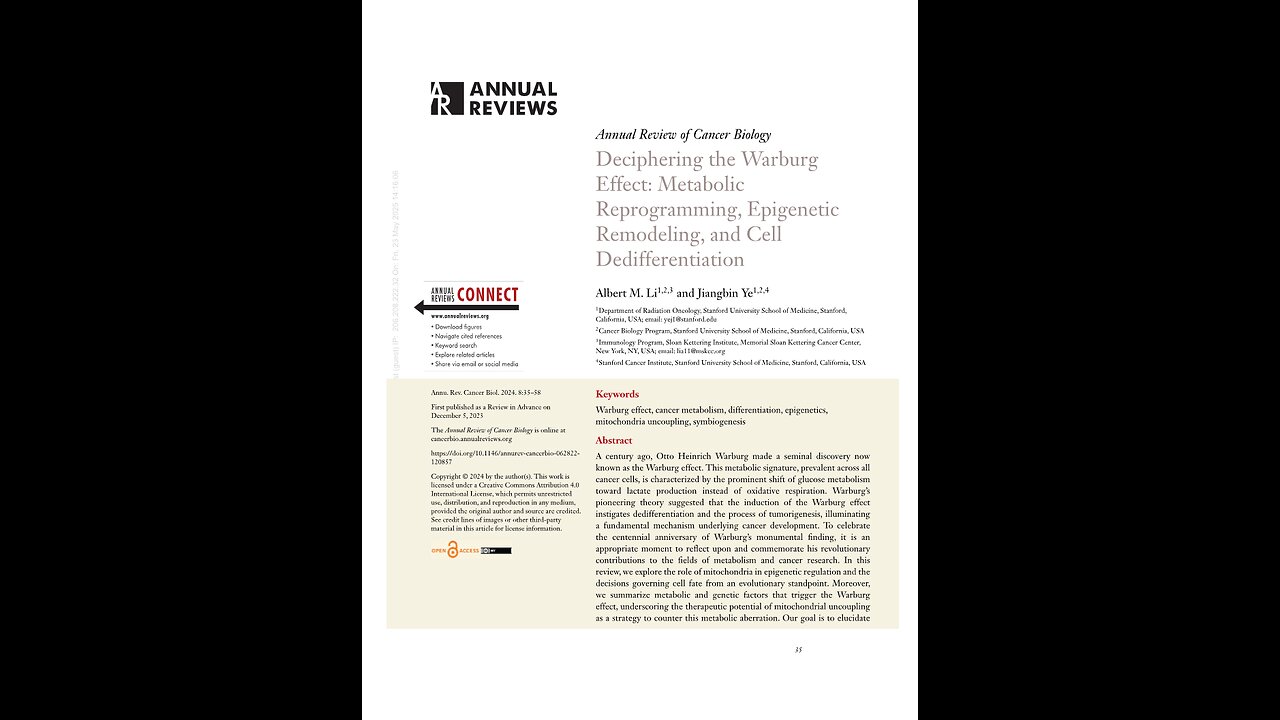Premium Only Content

Deciphering the Warburg Effect. Li and Ye, 2023. A Puke(TM) Audiopaper
Index of Other Science Articles:
https://rumble.com/v3t4yzj-index-of-science.-music-by-dan-vasc.html
https:--www.annualreviews.org-content-journals-10.1146-annurev-cancerbio-062822-120857
https:--doi.org-10.1146-annurev-cancerbio-062822-120857
Annual Review of Cancer Biology.
Deciphering the Warburg Effect.
Metabolic Reprogramming, Epigenetic Remodeling, and Cell De-differentiation.
Albert Li and Jiangbin Ye.
Department of Radiation Oncology, Stanford University School of Medicine, California, USA.
Keywords:
Warburg effect, cancer metabolism, differentiation, epigenetics, mitochondria uncoupling, symbiogenesis.
Abstract.
A century ago, Otto Heinrich Warburg made a seminal discovery now known as the Warburg effect. This metabolic signature, prevalent across all cancer cells, is characterized by the prominent shift of glucose metabolism toward lactate production instead of oxidative respiration. Warburg’s pioneering theory suggested that the induction of the Warburg effect instigates dedifferentiation and the process of tumorigenesis, illuminating a fundamental mechanism underlying cancer development. To celebrate the centennial anniversary of Warburg’s monumental finding, it is an appropriate moment to reflect upon and commemorate his revolutionary contributions to the fields of metabolism and cancer research. In this review, we explore the role of mitochondria in epigenetic regulation and the decisions governing cell fate from an evolutionary standpoint. Moreover, we summarize metabolic and genetic factors that trigger the Warburg effect, underscoring the therapeutic potential of mitochondrial uncoupling as a strategy to counter this metabolic aberration.
Our goal is to elucidate the means to induce tumor differentiation through metabolic therapy, thereby laying a foundation toward the cure for cancer.
One. THE WARBURG EFFECT AND DEDIFFERENTIATION.
German physiologist and biochemist Otto Heinrich Warburg (please see sidebar titled Otto Heinrich Warburg) first observed what is now known as the Warburg effect in the nineteen twenties while studying the metabolism of cancer tissue slices using the manometer, an instrument capable of measuring fluid or gaseous pressure, see Figure 1a. The Warburg effect refers to the observation that cancer cells preferentially rely on glycolysis over aerobic respiration, a comparatively efficient process that provides substantially more ATP per unit glucose consumed, to sustain normal cellular functions. Although anaerobic glycolysis is triggered normally under conditions of limiting oxygen, the Warburg effect occurs despite sufficient oxygen availability, a paradox often referred to as aerobic glycolysis. Indeed, this enigma of why cancer cells opt for such an inefficient way to produce energy, wasting the lactate by-product through secretion instead of directing the glucose-derived carbon substrates toward biosynthesis and respiration, has perplexed generations of cancer researchers. Later, in the nineteen fifties, after 30 years of research and thinking, Warburg concluded, in what is now viewed as his milestone review, that the consequence of the Warburg effect is that “the highly differentiated body cells are converted by this process into undifferentiated cells that grow wildly, the cancer cells”. This theory connects the metabolic hallmark of cancer, the Warburg effect, to the essence of tumorigenesis: dedifferentiation.
One point one. The Symbiogenesis Theory of Mitochondrion Origin.
In 19 13, Warburg identified cellular structures in liver cells, which he termed grana, as the locus of respiration. Subsequently, it was determined that these grana correspond to what is now recognized as the mitochondria. According to Warburg’s hypothesis, while the Warburg effect may appear to occur in the cytosol, the true underlying cause is the inhibition of mitochondria respiration.
OTTO HEINRICH WARBURG.
Otto Heinrich Warburg, a German physiologist and biochemist (October 8, 18 83 to August 1, 19 70), is renowned today primarily for his discovery of the Warburg effect. He was awarded the Nobel Prize in Physiology or Medicine in 1931 for his groundbreaking discovery of the catalytic role played by iron porphyrins in biological oxidation processes.
Methodologically, Warburg improved the techniques of manometry, see Figure 1a, and innovatively began employing tumor tissue slices for respiratory measurement, which laid the groundwork for the discovery of the Warburg effect. Furthermore, he was the first to find that reduced pyridine nucleotides demonstrate peak absorption at 340 nano Meters, a breakthrough that made the measurement of the rate of redox reactions possible. Warburg also established the principle of assessing the reaction rate of nonredox reactions by linking them to redox reactions. This concept not only represented a technological advancement but also highlighted that redox reactions are the driving force of cellular metabolism.
In addition to the Nobel Prize, other honors and awards Warburg received include foreign membership of the Royal Society, an honorary doctorate of Oxford University, the German Order of Merit, and the Freedom of the city of Berlin.
Figure 1
Manometers in the Otto-Warburg-Haus.
(a) Warburg’s manometer, a U-shaped tube that is used to measure pressure change. The photo was taken in
(b) The Otto-Warburg-Haus, originally established by Otto Warburg as the Kaiser Wilhelm Institute for Cell Physiology in 19 30. Following Warburg’s passing, the building transitioned into the Archive of the Max Planck Society in 19 75. Notably, a statue of Emil Fischer, Warburg’s mentor during his pursuit of a chemistry degree, stands proudly in front of the building. Fischer was awarded the Nobel Prize in Chemistry in nineteen oh two for his work on sugar and purine structures and syntheses.
(c) Friedhof Dahlem serves as the final resting place of Warburg.
It thus stands to reason that mitochondrial activity may play a pivotal role in controlling differentiation.
How might differentiation have fallen under the control of mitochondria? As esteemed evolutionary biologist Theodosius Dobzhansky said, “Nothing in biology makes sense except in the light of evolution”. Thus, to fully comprehend the link between the Warburg effect and cell dedifferentiation, we need to first scrutinize eukaryotic cell differentiation through the lens of evolutionary biology.
Approximately 2.4 billion years ago, the Great Oxygenation Event, for aerobes, or the Oxygen Catastrophe, for anaerobes, initiated due to photosynthesizing cyanobacteria. These organisms transformed the primitive reducing atmosphere into an oxidative one. Given the highly oxidative properties of oxygen, it served as an ideal final electron acceptor, thus providing a selective advantage for aerobic bacteria capable of performing biological oxidation via the electron transport chain, E T C. These primordial aerobes are widely believed to be the precursors of modern mitochondria.
The symbiogenesis theory of mitochondrion origin was first proposed by the Russian biologist Konstantin Mereschkowski in nineteen oh five. Mereschkowski suggested that chloroplasts and mitochondria, both organelles found in eukaryotic cells, evolved from endosymbiotic relationships between free-living bacteria and host cells. This theory postulates that the ancestor of eukaryotic cells (protozoa) engulfed a free-living aerobic bacterium, possibly related to modern-day alpha-proteobacteria, through a process termed endosymbiosis. Rather than being digested, the engulfed bacterium survived and formed a mutualistic relationship with the host cell.
Over time, the bacterium and host cell coevolved, with the bacterium providing energy through aerobic respiration and the host cell providing a stable environment and nutrients for the bacterium.
Figure 2.
The symbiogenesis theory of mitochondrion origin. Schematic comparing modes of energy acquisition utilized by pre-endosymbionts during the early days of life on earth, with the partitioning of energy generation in the mitochondria in present-day, differentiated eukaryotic cells.
(a) It is likely that a free-living aerobic bacterium survived engulfment by an early ancestor of eukaryotes, forming a mutualistic relationship with the host organism to give rise to organelles we now know as mitochondria.
(b) Over time, many genes in the mitochondrial genome integrated into the host cell nuclear genome, likely through plasmid transfer, bearing semblance to the architecture of modern eukaryotic cells.
(c) The division of labor between different cellular compartments is shown in the example of a neuron. The eukaryotic nuclear genome provides the instructions to synthesize a large portion of the mitochondrial proteome, and in turn, the mitochondria produce energy and communicate the metabolic state to the cell through the secretion of metabolites.
This symbiotic relationship eventually led to the integration of the bacterial genome into the host cell’s genome, resulting in the formation of a permanent organelle, the mitochondrion, as shown in Figure 2. Similarly, the cyanobacteria that initiated the Great Oxygenation Event coevolved with protozoa to become chloroplasts.
1 point 2. The High Energy Supply from Mitochondria Enables Differentiation.
Acquiring mitochondria proved to be pivotal during eukaryotic evolution, as these organelles provided organisms with a new source of energy to pave the way for new, complex life forms better equipped to survive in metabolically challenging environments. Prior to the adaptation toward mitochondrial energy generation, primordial cells relied on anaerobic metabolism, a strikingly less efficient process than its counterpart, aerobic metabolism as shown in Figure 2. By contrast, mitochondria harness electrochemical potential energy through a process initiated by proton pumping out of the matrix into intermembrane space. These protons are captured by ATP synthase as they flow back down the gradient into the matrix to generate ATP, the main cellular energy currency.
This process, also known as oxidative phosphorylation, produces much more ATP, greater than 30 ATP, than anaerobic metabolism (2 ATP) per molecule of glucose metabolized. This increased energy production endowed eukaryotic cells with the ability to perform more complex functions such as cell signaling and motility, enabling the development of multicellularity and hierarchically organized tissue and organ systems that are the results of cell differentiation.
Cell differentiation is the process by which unspecialized cells, such as stem cells, gain functional specification to develop into specialized cells such as muscle cells or nerve cells. During differentiation, gene expression and metabolic pathways are tightly and coordinately regulated to ensure proper cell function. Because all specialized physiological functions, such as muscle contraction, neural signaling transmission, and gland secretion, require large amounts of ATP, it is perhaps unsurprising that acquisition of mitochondria preceded the ability to engage cell differentiation in eukaryotes. For example, in muscle cells, the rate of ATP breakdown ranges from 70 to 140 milli moles per minute during static contraction to as high as 400 milli moles per minute during intense, dynamic activity. Brain tissue has been estimated to consume ATP at a lower magnitude, around 4.8 milli moles per minute. By contrast, developing embryos experience turnover of total cellular ATP in 1 min, corresponding to an ATP consumption rate of 1.5 milli moles per minute. From these measurements, it is tempting to speculate that ATP consumption positively correlates with the degree of tissue differentiation.
Indeed, pluripotent embryonic stem cells exhibit a metabolic profile similar to that of cells engaging the Warburg effect. This includes a preference for glycolysis and repression of oxidative phosphorylation, while differentiation is associated with mitochondrial biogenesis and increased oxidative phosphorylation. Notably, E T C inhibition can disrupt the cardiac differentiation process. Moreover, the process of generating induced pluripotent stem cells, iPSC’s from somatic cells has been shown to be associated with a metabolic switch from oxidative phosphorylation to glycolysis. A recent study of in vivo solid tumor metabolism attributed the unexpectedly slow tricarboxylic acid (TCA) cycle and ATP synthesis flux to a reduced energy demand associated with loss of specialized tissue function following transformation, in line with Warburg’s original hypothesis.
In summary, acquiring mitochondria proved to be a crucial step in the evolution of eukaryotic cells, as it provided eukaryotes with a more efficient source of energy and allowed for the development of complex life forms. By providing new functions such as efficient energy production, endomembrane system development, and environmental adaptation, the mitochondrion is the key to cell differentiation and evolution. This explanation underpins why real multicellular organisms with tissue differentiation emerged only after the Great Oxygenation Event.
1 point 3. How Can Mitochondria Sense Environmental Stresses and Communicate with the Nucleus?
During the process of endosymbiosis and the subsequent evolution of mitochondria, the mitochondrial genome has undergone significant changes, particularly a reduction in the size of the mitochondrial genome. The genomes of free-living bacteria are typically circular DNA molecules that contain many genes necessary for bacterial metabolism and growth. However, the mitochondrial genome is much smaller and more compact by comparison, because many ancestral bacterial genes have been lost or transferred to the nuclear genome, where they are now regulated by the host cell’s transcriptional machinery. The modern human mitochondrial genome is a small, circular, double-stranded DNA molecule of approximately 16.6 kilobases in length and contains only 37 genes that encode for 13 proteins involved in oxidative phosphorylation, 22 transfer RNAs, and 2 ribosomal RNAs required for mitochondrial protein synthesis.
HANS KREBS.
Hans Krebs, one of Warburg’s trainees, discovered the tricarboxylic acid cycle, also known as the Krebs cycle, earning him the Nobel Prize in 1953. Krebs, despite his mentor’s assertions, did not subscribe to the idea that the Warburg effect was the “prime cause of cancer.” As he mentioned: “Warburg’s ‘prime cause of cancer’, the replacement of respiration by fermentation, may be a symptom of the primary cause, but is not the primary cause itself. The primary cause is to be expected at the level of the control of gene expression, the minutiae of which are unknown though some of the principles involved are understood.”
Just as in any relationship, effective communication is pivotal to preserving health and functionality. The nucleus is responsible for encoding more than 800 mitochondria-targeted proteins, while the mitochondria itself does not encode any proteins with the ability to migrate to the nucleus and regulate gene expression. These observations prompt the question: How can mitochondria sense environmental stressors and relay signals to the nucleus to, in turn, modulate gene expression and differentiation? This lack of understanding explains why most scientists, including one of Warburg’s most accomplished trainees, Hans Krebs, dismissed Warburg’s theory, disagreeing with his claim that the replacement of respiration with fermentation was the “primary cause of cancer”, see sidebar titled Hans Krebs. Fortunately, recent discoveries have revealed the missing link between metabolism and differentiation: epigenetics.
Two. MITOCHONDRIAL METABOLITES FUNCTION AS SIGNALING MOLECULES TO REGULATE THE EPIGENOME.
Emerging evidence suggests that the metabolic state of a cell can influence its differentiation fate, in support of Warburg’s hypothesis. One proposed mechanism for the connection between the Warburg effect and cell differentiation is through the regulation of epigenetic modifications, which are reversible modifications added to DNA and histones to regulate gene expression. In cancer, these connections are supported by the observation that oncogenic mutations in the genes encoding metabolic enzyme isocitrate dehydrogenase 1-2 (IDH1-2) are often mutually exclusive with mutations in the DNA demethylase ten-eleven translocation 2 (TET2), indicating the existence of an epistatic relationship between small-molecule metabolites and epigenetic function. Epigenetics is the study of heritable changes in gene expression that occur without changes to the DNA sequence itself. These changes involve covalent modifications to the structure of DNA or associated proteins, including histones, that either promote or inhibit gene transcription. All epigenetic modifications are reversible, thereby endowing cells with the plasticity to adapt to a myriad of environmental signals and stressors. Epigenetic modifications that can be passed down from one generation to the next can have significant impacts on an organism’s phenotype, and disruptions to normal epigenetic regulation have been linked to a variety of diseases, including cancer.
Some of the key metabolites involved in epigenetic modifications, as shown in Figure 3 include:
One. Acetyl-coenzyme A, acetyl-CoA: Acetyl-CoA is a substrate for histone acetyltransferases, HAT’s, which add acetyl groups to histone proteins in chromatin. This modification can lead to a more open chromatin structure that is permissive for gene expression.
Two. alpha-Ketoglutarate, alpha-KG: alpha-KG not only is an intermediate of the TCA cycle but also serves as a vital substrate that, upon binding to the catalytic site of histone-DNA demethylases, facilitates oxygen-dependent hydroxylation and demethylation reactions.
Figure 3.
Metabolic regulation of epigenetics.
(a) Major metabolic pathways fuel mitochondrial metabolism that outputs substrates, cofactors, and inhibitors for enzymes involved in epigenetic regulation. Glucose and acetate are major sources of acetyl-CoA, which is needed for histone acetylation. Restricting glucose or serine impairs glycolytic flux to acetyl-CoA, leading to hypoacetylation. Electron transport chain activity is critical to maintain regeneration of NADplus, a cofactor for sirtuins. Glutamine is a major source of alpha-KG necessary to support histone and DNA demethylation. The same demethylases are inhibited by structural analogs of alpha-KG such as succinate, fumarate, and both d- and l-enantiomers of 2-HG that can arise from genetic lesions or microenvironmental stresses.
(b) Regulation of various chromatin writers and erasers by TCA cycle metabolites or cofactor pairs. Metabolites are color-coded for ease of identification. Metabolites associated with active respiration and open chromatin are in green, whereas metabolites linked to impaired respiration and compact chromatin are in purple. Orange denotes metabolic enzymes. PDK acts as the pivotal switch that impedes pyruvate’s entry into the TCA cycle; hence, it is highlighted in red.
Three. Succinate and fumarate: Both metabolites are TCA cycle intermediates downstream of alpha-KG, acting as competitors of alpha-KG to inhibit alpha-KG-dependent histone-DNA demethylases.
Four. Nicotinamide adenine dinucleotide, NAD plus: NAD plus is a cofactor for histone deacetylation. Sirtuins, also known as class three histone deacetylases, HDAC’s, are a family of enzymes that require NAD plus.
Five. Flavin adenine dinucleotide, FAD plus: FAD plus is a cofactor for histone demethylation. LSD1, lysine-specific demethylase 1, uses FAD plus to oxidize methylated lysine residues, forming a reactive intermediate that can be hydrolyzed to remove the methyl group.
Six. ATP: ATP serves both as a source of energy required for many enzymatic reactions involved in epigenetic modifications and as the substrate of kinases that phosphorylate histones.
Seven. S-Adenosylmethionine, SAM: SAM is a methyl donor for DNA and histone methylation.
Most of these metabolites are generated from or participate in TCA cycle reactions. When mitochondria sense environmental stimuli or stresses, the E T C and-or TCA cycle activity can be altered, driving changes in metabolite levels that eventually remodel epigenetics to regulate transcription and dictate cell fate decisions.
Three. DYSREGULATION OF HISTONE ACETYLATION.
Acetylation of lysine-arginine residues commonly found on histone tails neutralizes the positive charges of histones, thereby weakening their interactions with the negatively charged phosphate backbone of DNA to allow access to RNA polymerase and transcription factors. Histone acetylation is commonly associated with an open chromatin structure that permits transcriptional machinery binding at gene promoter and enhancer regions to initiate transcription. In the context of cell differentiation, histone acetylation can facilitate the activation of specific genes required for differentiation. Given that acetyl-CoA generated in the mitochondria is generally inaccessible for immediate utilization by nuclear HATs to acetylate histones, this metabolite must first be converted into citrate. Citrate is then exported out of the mitochondria and subsequently reconverted into acetyl-CoA by ATP citrate lyase (ACLY). This process allows acetylation reactions to occur within the cytosol and nucleus. Therefore, any stress condition that impairs the conversion of pyruvate to acetyl-CoA and citrate, exportation of citrate from mitochondria, and-or the conversion of citrate to acetyl-CoA in the cytosol-nucleus will likely cause histone hypoacetylation. This in turn may inhibit the expression of cellular markers associated with differentiation. Notably, the acyl-coenzyme A synthetase short chain (ACSS) family enzymes play a crucial role in the direct conversion of exogenous acetate to acetyl-CoA, an adaptation that enables cancer cells to compensate for acetyl-CoA depletion under stress conditions.
3 point 1. Mitochondrial Pyruvate Carrier, Histone Hypoacetylation, and Stemness.
Reduced histone acetylation can arise from lesions of genes encoding metabolic enzymes- transporters or various stress conditions. One such example in cancer is the commonly observed deletion or low expression of the mitochondrial pyruvate carrier (MPC), a protein complex that transports pyruvate into the mitochondria. Subsequently, this pyruvate is converted into acetyl-CoA, which can ultimately support histone acetylation. The MPC is composed of two subunits, MPC1 and MPC2, and altering the expression or activity of either of these subunits is predicted to impact the function of the entire complex, contributing to metabolic reprogramming and the Warburg effect.
Loss or reduced expression of MPC subunits can be caused by different mechanisms, such as:
Genetic deletions: Deletions in the genes encoding MPC or downregulation of gene expression can lead to loss of function or reduced function of the MPC complex. The knockout of Mpc1 in colon cancer models may promote tumor initiation by inducing histone hypoacetylation and enhancing stemness, underscoring an important connection between pyruvate metabolism and cell fate. Conversely, MPC overexpression blocks transformation and inhibits tumor growth.
Epigenetic regulation: H3K4 demethylation at the MPC1 gene promoter through KDM5A can downregulate MPC1 expression levels in pancreatic cancer.
3 point 2. Stress Conditions that Reduce Histone Acetylation.
Under the metabolic stress conditions present in the tumor microenvironment, such as hypoxia and nutrient deprivation, a deficiency in acetyl-CoA can lead to histone hypoacetylation.
3 point 2 point 1. Hypoxia.
Solid tumors often harbor low oxygen levels, a condition also known as hypoxia and a major trigger of the Warburg effect in solid tumors.
While the Warburg effect is characterized by increased lactate production from glycolysis even in the presence of oxygen, the increased glycolytic activity and lactate production under hypoxia still align with the broader concept of the Warburg effect. Hypoxia can lead to altered chromatin structure and reduced histone acetylation as cells adapt to low-energy conditions. Despite reducing proliferation, at least acutely, hypoxia also lowers acetyl-CoA levels and impairs histone acetylation that, in certain contexts, may drive silencing of differentiation marker expression, leading to more aggressive tumor phenotypes.
3 point 2 point 1 point 1. Pyruvate dehydrogenase kinase induction.
Following transport through the MPC, pyruvate is converted by pyruvate dehydrogenase (PDH) to acetyl-CoA inside the mitochondria.
The metabolic switch that triggers global histone hypoacetylation involves the hypoxia-mediated induction of pyruvate dehydrogenase kinases, PDK1 and PDK3, that control the fate of pyruvate through phosphorylation-mediated PDH inhibition. Inhibiting PDKs with dichloroacetate, DCA, restores acetyl-CoA generation from pyruvate and histone acetylation levels, two processes typically lost under hypoxia. Furthermore, PDK1 knockdown induces neuroblastoma cell differentiation, suggesting a critical role for PDK1 in cell fate control. ATAC-seq analysis revealed that hypoxia significantly reduces chromatin accessibility at RAR-RXR binding sites of genes involved in neuron differentiation. Notably, acetate or glycerol triacetate (GTA) supplementation reestablishes neuronal differentiation under hypoxia by restoring chromatin accessibility and gene expression, highlighting acetyl-CoA deficiency as a key consequence of impaired PDK activity.
3 point 2 point 1 point 2. Lactate accumulation.
Histone lactylation is a newly discovered histone modification involving the addition of a lactate group to lysine residues. The addition of lactate groups modulates the electrostatic interaction between histone tails and DNA to either activate or repress the transcription of specific genes. Because histone acetylation and lactylation are negatively correlated, an increase in lactylation is predicted to drive a corresponding reduction in acetylation. Due to increased lactate production under hypoxia-induced Warburg effect, lactylation increases under hypoxic conditions or E T C inhibitor treatment. In turn, inhibiting PDKs and lactate dehydrogenase (LDH) with DCA and oxamate, respectively, reduces lactate levels and histone lactylation. The precise role of histone lactylation in cancer progression or differentiation is still unclear. In the case of ocular melanoma patients, increased levels of histone lactylation have been associated with an unfavorable prognosis. This adverse outcome may be attributed to its potential role in promoting the expression of the YT521-B homology N6-methyladenosine RNA binding protein F2, YTHDF2. In addition, histone lactylation may play a role in the regulation of macrophage polarization, with M2-polarized macrophages typically associated with immunosuppression and tumor progression. Intriguingly, similar to acetylation, lactylation modifications may be deposited and removed by the acetyltransferase p300 and HDAC1-3, respectively, suggesting that the function of these enzymes depends on intracellular substrate availability.
3 point 2 point 2. Nutrient deprivation.
Recent studies indicate that starvation or nutrient deprivation reduces histone acetylation as cells adapt to a low-energy state.
3 point 2 point 2 point 1. Glucose starvation.
Glucose starvation triggers loss of histone acetylation, hypo-acetylation, by suppressing glycolysis and TCA cycle flux, ultimately suppressing acetyl-CoA dependent gene expression programs.
The contribution of glucose to acetyl-CoA generation and histone acetylation depends on the nucleocytosolic enzyme ACLY, with an essential role demonstrated during adipocyte differentiation and during myoblast-satellite cell differentiation in myogenesis.
In cancer cell lines, limiting glucose to levels that could still support stable doubling times and cell viability dramatically depleted histone acetylation. Similarly, 2-deoxy-d-glucose treatment mimicked glucose starvation to reduce histone acetylation in a dose-dependent manner. Moreover, in glioblastoma cells, glucose withdrawal compromised the expression of several important genes involved in cell migration and adhesion to the extracellular matrix, presumably due to the coordinated depletion of site-specific histone H3 lysine 27 acetylation (H3K27ac) and defective acetylation-dependent nuclear translocation of the transcription factor NFAT1. These results demonstrate a critical role for glucose-dependent gene expression and suggest that cancer cells growing in glucose-limited conditions may face evolutionary pressures to acquire acetyl-CoA from alternative sources such as acetate or glutamine. Whether the loss of histone acetylation under glucose starvation contributes to cell dedifferentiation is a question that necessitates further investigation.
3 point 2 point 2 point 2. Serine starvation.
Pyruvate kinase catalyzes the final step of glycolysis, converting phosphoenolpyruvate to pyruvate, which feeds into the TCA cycle to support acetyl-CoA generation. Pyruvate kinase M2, PKM2, is the major isoform expressed in cancer. In addition to being activated by fructose-1, 6-bisphosphate and inhibited by tyrosine kinase signaling, PKM2 is allosterically activated by the nonessential amino acid serine. In breast cancer cells, limiting serine levels can impair nucleocytosolic acetyl-CoA production from glucose, resulting in H3K27ac depletion, particularly at the promoter region of genes associated with the estrogen receptor E R pathway, including ESR1, which encodes ERalpha, a key transcription factor that regulates mammary gland development and differentiation. Consistent with this model, inhibiting the mitochondrial citrate exporter SLC25A1 leads to suppressed H3K27ac and ERalpha expression, whereas providing an alternate source of acetyl-CoA such as acetate restores histone acetylation and gene expression under serine-free conditions.
3 point 3. Epigenetic-Metabolic Therapies that Can Restore Histone Acetylation.
At present, two strategies are being explored to restore histone acetylation: inhibiting HDAC activity and increasing cellular acetyl-CoA levels.
3 point 3 point 1. Histone deacetylase inhibitors.
HDACs remove acetyl groups from histones in chromatin, causing compaction and less accessible chromatin structures that limit gene expression.
Thus, HDAC inhibitors, HDAC i, can counteract the effects of dysregulated HDACs in cancer, leading to increased histone acetylation and a more open chromatin structure permissive for gene expression. Consequently, previously silenced tumor suppressor genes are reactivated, promoting cell cycle arrest, apoptosis, and differentiation. The FDA has approved multiple HDAC i for cancer treatment, including vorinostat, also known as SAHA or Zolinza, romidepsin, belinostat, and panobinostat. The successful application of HDAC i in cancer treatment lends credence to the idea that histone hypo-acetylation may promote tumor progression. Despite clinical efficacy in specific hematological malignancies, the use of these HDAC i in solid tumors is still under investigation. Side effects associated with HDAC i predominantly consist of fatigue, nausea, dehydration, diarrhea, elongated QT intervals, thrombocytopenia, lymphopenia, and neutropenia.
3 point 3 point 2. The pyruvate dehydrogenase kinase inhibitor dichloroacetate.
DCA is a small molecule inhibitor of PDK. By inhibiting PDK, DCA increases the activity of the pyruvate dehydrogenase complex, promoting the conversion of pyruvate to acetyl-CoA to restore acetyl-CoA production and histone acetylation.
DCA has been evaluated in several preclinical studies and a limited number of early-phase clinical trials in cancer patients. Although some initial studies showed promising results, the overall clinical efficacy of DCA in cancer remains inconclusive.
While the most severe, commonly encountered side effect is peripheral neuropathy, sporadic cases of delirium and gastrointestinal symptoms have also been reported.
3 point 3 point 3. Acetate supplementation.
If hypo-acetylation in cancer is attributed to overexpression or activation of HDAC’s, then employing HDAC i will logically be the appropriate treatment approach. Conversely, if the cause of histone hypoacetylation is an insufficient acetyl-CoA supply under stress conditions, then the course of treatment will logically focus on restoring cellular acetyl-CoA levels. Through the action of ACSS’s, supplementing cells with acetate can effectively boost acetyl-CoA levels and histone acetylation. Compared to acetate, GTA, owing to its hydrophobicity, displays enhanced ability to cross the blood-brain barrier and plasma membranes, making it an ideal therapeutic for acetate supplementation.
Acetate supplementation in cancer revealed a role for acetate-mediated induction of cellular apoptosis, tumor necrosis, and growth arrest. In contrast to the myriad side effects encountered by patients administered HDAC i or DCA, even high doses, 4.5 grams per kilogram per day of GTA do not elicit significant side effects or toxicity in infants.
Acetate and GTA likely boost histone acetylation through at least two distinct mechanisms: by providing substrates for increased de novo acetylation and by product inhibition of deacetylation. In particular, acetate or GTA supplementation rescues histone acetylation defects triggered by genetic deletion of ACLY or stress-induced reduction of glucose flux to the TCA cycle, presumably by supplying surplus acetyl-CoA for HATs. In neuroblastoma cells, acetate supplementation rescues the hypoxia-mediated differentiation block by restoring chromatin accessibility and expression of differentiation-related genes. In addition, acetate inhibits class one to two HDAC’s to promote histone acetylation. In proliferating cells, nutrient signaling suppresses histone deacetylation by promoting the nuclear translocation and activity of the glycolytic enzyme TPI1, preventing nuclear dihydroxyacetone phosphate from scavenging local acetate.
Four. DYSREGULATION OF DNA AND-OR HISTONE METHYLATION.
DNA promoter hypermethylation and histone hypermethylation are epigenetic changes frequently observed in cancer. These modifications can contribute to the silencing of tumor suppressor genes and differentiation markers to promote cancer progression. Because both JMJD family histone demethylases and the DNA demethylase TET are dioxygenases that use alpha-KG as substrate, these enzymes may be subject to inhibitory regulation from metabolites that share similar structure with alpha-KG through active-site competition, or these enzymes may exhibit impaired activity when alpha-KG levels are low.
4 point 1. Genetic Lesions that Cause DNA and-or Histone Hypermethylation.
In cancer, mutations in TCA cycle metabolic enzymes can lead to the aberrant accumulation of fumarate, succinate, or 2-hydroxyglutarate (2-HG), resulting in DNA and-or histone hypermethylation.
4 point 1 point 1. Mutant fumarate hydratase.
Fumarate hydratase (FH) heterozygous mutations are primarily associated with a rare cancer syndrome termed hereditary leiomyomatosis and renal cell cancer, HLRCC. HLRCC is characterized by the development of cutaneous and uterine leiomyomas, as well as by an aggressive form of renal cell carcinoma (RCC). FH mutations in HLRCC are germline mutations, predisposing patients to the development of HLRCC-associated tumors following the loss of the remaining functional FH allele in specific cells and thus leading to a complete loss of FH activity and the accumulation of fumarate up to millimolar levels. Fumarate accumulation and its effects on TET enzymes and JmjC domain-containing histone demethylases, JHDM’s, induce profound global epigenetic remodeling, altering the expression of various genes involved in cellular processes such as cell cycle regulation, DNA repair, apoptosis, and cell differentiation. Additional epigenetic mechanisms of cell transformation enabled by fumarate accumulation include induction of epithelial-to-mesenchymal transition (EMT) by DNA hypermethylation, suppression of antimetastatic microRNAs, and induction of cytosolic mitochondrial DNA release to trigger innate inflammation. Apart from HLRCC, somatic FH mutations have been reported in rare cases of other tumor types, such as testicular and ovarian cancers, but these occurrences are much less frequent. Notably, FH loss causes complex One and Two inhibition, triggering the Warburg effect. Fumarate-driven prolyl hydroxylase domain inhibition activates hypoxia-inducible factor (HIF) signaling as an additional means of inducing the Warburg effect.
4 point 1 point 2. Mutant succinate dehydrogenase.
Succinate dehydrogenase (SDH) participates in both the TCA cycle and the E T C during cellular respiration. Mutations in the genes encoding the subunits of SDH, SDHA, SDHB, SDHC, and SDHD, cause a truncation of the TCA cycle, resulting in elevated succinate levels, and have been associated with several types of cancers and hereditary cancer syndromes, including para-gangliomas and pheochromocytomas, gastrointestinal stromal tumors, RCC, and Carney-Stratakis syndrome.
SDH mutations lead to the accumulation of succinate, which, like fumarate, inhibits alpha-KG dependent dioxygenases, including prolyl hydroxylases, histone demethylases, and TET enzymes. The resultant epigenetic alterations activate HIF signaling to induce the Warburg effect and gene expression changes that favor tumor progression. Indeed, SDH-mutant tumor hyper-methylation preferentially affects PRC2 targets and known developmental genes to drive pseudohypoxia and an EMT-like phenotype. Moreover, para gangliomas harboring SDH mutations exhibited a hyper-methylator phenotype associated with downregulated expression of neuroendocrine genes. In these examples, the methylome of SDH-mutant cancer cells was recapitulated by TET inactivation, highlighting the importance of a functional TCA cycle in epigenetic maintenance through DNA demethylation.
4 point 1 point 3. Mutant isocitrate dehydrogenase.
IDH, an enzyme involved in the TCA cycle, exists in three isoforms with distinct enzymatic properties and cellular localizations: IDH1 (cytosolic), IDH2 (mitochondrial), and IDH3, mitochondrial and cytosolic. Gain-of function mutations in IDH1 and IDH2 are most frequently associated with cancers, which include:
Gliomas: IDH mutations, predominantly in the IDH1 gene, are frequently observed in diffuse gliomas, including low-grade gliomas such as diffuse astrocytomas and oligodendrogliomas, as well as high-grade gliomas like secondary glioblastomas.
Metabolomics analysis of human glioblastoma cells harboring the R132H mutation in IDH1 revealed that the mutant enzyme converts alpha-KG to d-2-hydroxyglutarate (d-2-HG), inducing the glioma CpG island methylator phenotype.
Acute myeloid leukemia (AML): IDH mutations, particularly in IDH1 and IDH2, have been identified in approximately 15 to 20 percent of AML cases. Ectopic expression of the canonical IDH R132H mutant promotes cytokine independence and a differentiation block in hematopoietic cells.
Chondrosarcomas: IDH mutations, especially in IDH1 and IDH2, have been reported in a subset of chondrosarcomas, a type of malignant bone tumor that produces cartilage matrix. Expression of mutant IDH2 (R172K) in mouse mesenchymal cells correlated with elevated 2-HG and led to DNA hyper-methylation, differentiation block, and sarcoma induction in vivo.
Intrahepatic cholangio carcinoma: A subset of intrahepatic cholangiocarcinomas, also known as bile duct cancers, harbor IDH1 and IDH2 mutations.
The common feature of IDH mutations in cancer is the production of d-2-HG. d-2-HG accumulation inhibits alpha-KG-dependent dioxygenases, leading to DNA and histone hypermethylation and a block in differentiation that promotes tumorigenesis.
4 point 2. Stress Conditions that Cause DNA and-or Histone Hypermethylation.
Beyond genetic mutations in TCA cycle enzymes, disturbances in the TCA cycle due to metabolic stress conditions in the tumor microenvironment, such as hypoxia and nutrient deprivation, can also lead to DNA and-or histone hyper-methylation.
4 point 2 point 1. Hypoxia.
Experimental evidence suggests that the l enantiomer of 2-HG (l-2-HG) is a more potent inhibitor of alpha-KG-dependent dioxygenases than is d-2-HG. In hypoxic tumor cells, l-2-HG can be generated as a by product of normal cellular metabolism through the promiscuous activity of LDH and malate dehydrogenase (MDH) through the direct conversion of alpha-KG to l-2-HG.
This side reaction appears to occur, at least in part, due to a lower NAD plus-NADH ratio that favors reductive biochemistry. Notably, a lower NAD plus-NADH ratio also favors conversion of pyruvate to lactate, promoting the Warburg effect. More recently, acidic pH has been proposed to promote more efficient docking of alpha-KG in the enzyme active site for l-2-HG production. In kidney cancer, loss of the von Hippel-Lindau (VHL) tumor suppressor is associated with increased 2-HG levels. Renal tumors display elevated levels of 2-HG associated with reduced DNA-histone demethylase activity, while l-2-HG accumulation in renal proximal tubule cells is associated with decreased DNA demethylation and increased histone methylation that coincide with impaired tubulogenesis and differentiation.
4 point 2 point 2. Glutamine depletion.
In addition to glucose, glutamine is another essential carbon source for many proliferating cell types. Metabolomics performed in solid tumors of both human and murine origin have highlighted a consistent depletion of intratumoral glutamine levels, particularly in tumor core regions, relative to levels found in the adjacent normal tissue. Possible causes of disrupted glutamine homeostasis include rapid consumption by highly proliferative cell types such as transformed cancer cells and tumor-infiltrating immune cells, although a recent report provided evidence of nutrient partitioning between these cell populations.
Low glutamine levels in the tumor microenvironment can compromise alpha-KG production, which in turn impairs the activity of various alpha-KG-dependent demethylases to enforce hypermethylation through the accumulation of methyl marks on DNA and histones. In melanoma cell lines and xenografts, low glutamine levels were associated with increased H3K27me3 and the concomitant repression of differentiation-related genes and induction of dedifferentiation related genes. Based on these discoveries, alpha-KG or glutamine supplementation has been applied in preclinical models to promote demethylation and treat cancer. In a pancreatic cancer model, alpha-KG supplementation partially recapitulated gene expression alterations induced by the reactivation of p53 through DNA demethylation. Alpha-KG supplementation in a colorectal cancer (CRC) model disrupted Wnt-driven cancer stemness programs to drive differentiation and restrict tumor growth. In a preclinical model of BRAF inhibitor-resistant melanoma, glutamine supplementation epigenetically suppressed oncogenic signaling pathways, impaired tumor growth, and improved sensitivity to mutant BRAF inhibition. Notably, alpha-KG-glutamine supplementation-mediated downregulation of CRC and melanoma oncogenes was linked to decreased H3K4me3, a histone modification typically found in transcriptionally active genes.
4 point 3. Epigenetic-Metabolic Therapies that Induce Promoter CpG Island Demethylation.
Currently, there are at least four strategies under investigation to induce demethylation of promoter CpG islands: inhibition of DNA methyl-transferase (DNMT) activity, suppression of mutant IDH (mIDH) activity, increasing substrate-cofactor levels for TET, and activation of the Electron Transport Chain to elevate the alpha-KG-2-HG ratio.
4 point 3 point 1. DNA methyltransferase inhibitors.
DNMTi target DNMTs, the enzymes responsible for adding methyl groups to DNA. These inhibitors are nucleoside analogs that incorporate into DNA and RNA, covalently binding to the catalytic site of DNMTs to elicit DNMT degredation, and the subsequent demethylation of DNA can reactivate silenced tumor suppressor genes to inhibit cancer cell growth. Two DNMT inhibitors, azacitidine (Vidaza) and decitabine (Dacogen), have been approved by the US Food and Drug Administration (US FDA) for the treatment of myelodysplastic syndromes, a group of hematologic disorders characterized by abnormal blood cell development and a high risk of progression to AML.
4 point 3 point 2. Mutant IDH inhibitors.
mIDH inhibitors specifically target the mutated IDH enzymes, suppressing the production of the oncometabolite d-2-HG to reverse the oncogenic effects associated with these mutations. Two mIDH inhibitors, ivosidenib (Tibsovo) and enasidenib (Idhifa), have been approved by the US FDA for the treatment of AML with IDH1 or IDH2 mutation, respectively. Both ivosidenib and enasidenib have shown clinical activity in patients with mIDH AML, leading to durable responses and, in some cases, complete remission. Notably, mIDH inhibitor treatment can select for cells carrying additional mutations, either
(a) In trans or in cis in the IDH genes or
(b) Through mutant isoform switching that ultimately leads to acquired resistance in cancer patients.
4 point 3 point 3. Vitamin C.
Vitamin C has emerged as a possible nutrient that can promote DNA demethylation and tumor cell differentiation primarily by acting as a cofactor for TET enzymes and JHDM’s. TET enzymes catalyze the oxidation of 5-methylcytosine to 5- hydroxymethylcytosine (5hmC), 5-formylcytosine, and 5-carboxylcytosine, which are then replaced with unmodified cytosines through the base excision repair pathway.
The cofactor function of vitamin C has been linked to direct enhancement of TET catalytic activity, possibly by promoting C-terminal catalytic domain folding of TET or by recycling the Fe2plus cofactor. In embryonic cells and iPSC’s, vitamin C treatment enriches 5hmC levels and promotes DNA demethylation associated with developmental processes. Systemic depletion of vitamin C enables hematopoietic stem cell (HSC) expansion and cooperates with Flt3ITD mutations to promote leukemo-genesis. Analogously, vitamin C induces 5hmC and DNA demethylation to reverse aberrant HSC self-renewal and promote myeloid differentiation in leukemia models. In both the Agathocleous et al from 20 17 and Cimmino et al from 20 17 studies, reversal of tumorigenesis was at least partially dependent on rescuing Tet function. As a cofactor for JHDM’s, vitamin C may also promote histone demethylation, although to what extent this effect is apparent in cancer differentiation remains unknown.
4 point 3 point 4. Mitochondrial uncouplers.
If promoter CpG island hyper-methylation in cancer is attributed to overexpression or activation of DNMTs, then employing DNMT i will logically be the appropriate treatment approach. Conversely, if the cause of DNA hyper-methylation is insufficient alpha-KG supply and-or increased 2-HG levels under stress conditions, then the course of treatment will logically focus on restoring cellular alpha-KG-2-HG ratios, determined by the cellular NAD plus-NADH ratio.
In 1934, Warburg isolated and identified nicotinamide, the precursor of NAD plus, a cofactor in numerous cellular redox reactions. Given that NAD plus-based redox reactions ultimately drive all cellular metabolic reactions, the NAD plus-NADH ratio emerges as a crucial determinant that governs a plethora of metabolic reactions, particularly select redox reactions in the mitochondria, including the conversions of pyruvate to acetyl-CoA (PDH), isocitrate to alpha-KG (IDH), alpha-KG to succinyl-CoA, oxoglutarate dehydrogenase, and malate to oxaloacetate (MDH). The NADH generated from these reactions is oxidized through E T C complex One to regenerate NAD plus. When the Electron Transport Chian is inhibited under hypoxia or when ATP is not consumed or synthesized fast enough, the high proton gradient inhibits E T C activity, causing NADH accumulation and a decrease in the NAD plus-NADH ratio. In addition to enhanced lactate production through LDH, this change also promotes the generation of l-2-HG to remodel the epigenome and inhibit differentiation. Hence, restoring the NAD plus-NADH ratio is the key to inhibiting the Warburg effect and reactivating differentiation.
Mitochondrial uncouplers are compounds that disrupt the coupling between the E T C and ATP synthesis in the mitochondria, allowing protons to leak across the inner mitochondrial membrane without generating ATP. This leads to increased Electron Transport Chain respiration to oxidize NADH back to NAD plus and increase the cellular NAD plus-NADH ratio, resulting in lower l-2-HG levels and thus promoting epigenetic remodeling and differentiation.
The cancer epigenome is generally characterized by global DNA hypo-methylation, which is associated with hyper-methylation in promoter CpG islands and hypo-methylation in gene bodies. Promoter hyper-methylation often results in the suppression of tumor suppressor and differentiation genes. In neuroblastoma cells, treatment with mitochondrial uncoupler niclosamide ethanolamine (NEN) not only induces promoter DNA demethylation, thus activating the expression of genes related to neuronal differentiation, but also increases gene body methylation. Intriguingly, the differential methylation sites induced by NEN are primarily found within the gene bodies of neuronal differentiation genes, implying that the methylation status within these regions may be instrumental in regulating gene expression and determining cell fate, in line with a previous report.
Treatment with mitochondrial uncouplers triggers global metabolic reprogramming, including an elevated NAD plus-NADH ratio and AMP-ATP ratio. These metabolic shifts may further influence other signaling pathways that rely on NAD plus or ATP, thereby remodeling the epigenetic landscape and altering cell fate. For example, NEN treatment activates AMPK, which phosphorylates and stabilizes TET. As such, it is plausible that the uncoupler induces epigenetic remodeling through multiple mechanisms or pathways, not solely by increasing the alpha-KG-2-HG ratio. In contrast to pan-demethylating agents like 5-AZA, which globally reduces DNA methylation, NEN reshapes the DNA methylation landscape by decreasing methylation in promoter regions while increasing it within gene bodies. These findings position NEN as a more specific and effective epigenetic strategy for cancer therapy.
Additionally, we uncovered that mitochondrial uncoupling suppresses reductive carboxylation, the sibling of the Warburg effect, in neuroblastoma cells under hypoxic conditions, during anchorage-independent growth and in VHL-null clear cell RCC. This finding underscores the critical role of the NAD plus-NADH ratio as a decisive switch dictating the metabolic fate of alpha-KG.
Numerous mitochondrial uncouplers have demonstrated anticancer activity in preclinical studies. These include 2, 4-dinitrophenol, carbonyl cyanide-p-trifluoromethoxyphenylhydrazone, and carbonyl cyanide m-chlorophenyl hydrazone. To date, at least two of these uncouplers, niclosamide and nitazoxanide, have received FDA approval for treating parasites in humans, and oxyclozanide has been approved for veterinary use. Common side effects in patients include gastrointestinal discomfort such as nausea, vomiting, stomach pain, and diarrhea, with less frequent reports of dizziness and skin rashes, in the case of niclosamide, and headaches, in the case of nitazoxanide. Compared to first-line chemotherapy drugs, these mitochondrial uncouplers exhibit milder side effects in patients. This suggests the potential for repurposing these uncouplers as safe and effective cancer treatments.
Five. CONCLUSION AND PROSPECTS.
While Warburg originally defined his observations of cancer cell metabolism from the perspective of increased lactate generation at the expense of glucose oxidation in the mitochondria, we now understand that the ultimate cause of the Warburg effect is the inhibition of Electron Transport Chain and the reduction of cellular NAD plus-NADH ratios, leading to altered metabolite levels that are needed for maintaining the epigenetic landscape. The ability of many of these cofactors and metabolites to influence chromatin-modifying enzymes thereby links cellular metabolism with epigenetic state and cell fate. The observation that the E T C inhibitors antimycin and rotenone block cardiac differentiation suggests that a functional E T C is necessary for differentiation. Nonetheless, whether inhibiting the Warburg effect alone is sufficient to induce differentiation remains a topic of further investigation. This may be accomplished by employing additional molecular tools capable of modulating cellular redox states.
By directly altering mitochondrial function to tune whole-cell redox state, mitochondrial uncouplers circumvent issues presented by metabolite supplementation alone. Because many enzymatic reactions in central carbon metabolism are gated not only by substrate availability and product inhibition but also by cofactor availability, the relative ratio of the metabolic cofactor pair NAD plus and NADH may ultimately dictate the fate of these metabolites. Thus, to avoid l-2-HG production, maximal effectiveness of alpha-KG or glutamine supplementation as an epigenetic therapy may require priming by optimal NAD plus-NADH conditions, such as those achieved with mitochondrial uncoupling.
It is expected that mechanistic studies investigating combination metabolic intervention therapies are forthcoming.
In most forms of cancer, the degree of differentiation is a key prognostic marker and typically associated with a more favorable outcome. In general, well-differentiated tumors resemble the normal tissue of origin and tend to grow and spread at a slower rate compared to poorly differentiated or undifferentiated tumors. The latter often display aggressive growth and metastasis, signifying a more severe prognosis. Some neuroblastoma tumors undergo spontaneous differentiation and regression or even completely regress, disappearing altogether without treatment. These observations have sparked our enthusiasm for the possibility of harnessing our understanding of the Warburg effect to trigger cancer cell differentiation and potentially tumor regression through metabolic interventions. A major theme that has emerged in the studies of metabolic regulation of epigenetics is that the anticancer effect of metabolic manipulation often occurs in the presence of strong oncogenic alterations, as in the case of MPC overexpression counteracting Apc or Pten loss; glutamine or alpha-KG supplementation activating p53 and counteracting Wnt or mutant Braf signaling; and mitochondrial uncoupler NEN treatment promoting neuroblastoma differentiation, activating p53, and inhibiting N-Myc, E2F, and beta-catenin signaling. Almost all cancer drivers such as Ras mutation, Myc amplification, and p53 have been linked to altered cancer cell metabolism, as reviewed elsewhere. Yet, the mutation-agonistic ability of metabolic alterations to induce tumor regression and gene expression changes associated with cell differentiation highlights the therapeutic potential of metabolic interventions across a broad spectrum of malignancies, either as single agents or in combination therapies.
SUMMARY POINTS.
1. The Warburg effect is triggered by the inhibition of the electron transport chain, E T C, which subsequently leads to epigenetic remodeling and induces cellular dedifferentiation.
2. Differentiated cells typically exhibit higher ATP demand and consumption rates. In contrast, progenitor cells often display the Warburg effect and exhibit elevated glycolysis rates. During the process of differentiation, they transition to oxidative phosphorylation.
3. Mitochondria originated from proteobacteria via a process known as symbiogenesis.
Throughout this coevolutionary journey, mitochondria transferred most of the mitochondrial genome to the nucleus. To sustain this interorganellar communication, the mitochondria and the nucleus coevolved to establish the epigenetic system. Through this system, mitochondria can modulate gene expression using mitochondrial metabolites.
4. Hypoxia or nutrient deprivation can lead to a reduction of acetyl-CoA levels, subsequently resulting in histone hypoacetylation and reduced chromatin accessibility.
Consequently, the expression of differentiation markers is silenced.
5. Histone acetylation can be effectively restored through various methods, including the use of histone deacetylase inhibitors and pyruvate dehydrogenase kinase inhibitors such as dichloroacetate and by supplementing with acetate or glycerol triacetate.
6. The accumulation of metabolites such as succinate, fumarate, and 2-hydroxyglutarate can inhibit alpha-ketoglutarate-dependent histone-DNA demethylases.
This inhibition leads to hyper-methylation of histones and DNA, subsequently causing a block in cellular differentiation.
Seven. Hyper-methylation of promoter CpG islands can be reversed using various approaches, including the use of DNA methyl-transferase inhibitors, mutant isocitrate dehydrogenase inhibitors, vitamin C, and mitochondrial uncouplers.
Eight. The Warburg effect is indicative of Electron Transport Chain inhibition and a disruption of redox homeostasis, specifically reduction of the NAD plus-NADH ratio. Consequently, employing mitochondrial uncouplers to restore E T C activity and the NAD plus-NADH ratio represents an optimal strategy for reversing the Warburg effect, remodeling the epigenome, and reactivating the differentiation program.
DISCLOSURE STATEMENT.
ACKNOWLEDGMENTS.
LITERATURE CITED.
-
 17:44
17:44
The Pascal Show
13 hours ago $1.24 earnedNOW LAPD IS LYING?! TMZ Doubles Down On Source's "Celeste Rivas Was FROZEN" Claims
8.43K1 -
 18:05
18:05
GritsGG
14 hours agoThis Duo Lobby Got a Little Spicy! We Have Over 20,000 Wins Combined!
9.43K -
 LIVE
LIVE
Lofi Girl
3 years agolofi hip hop radio 📚 - beats to relax/study to
256 watching -
 37:08
37:08
MetatronGaming
2 days agoWarhammer Shadow of The Horned Rat DOS Version is FANTASTIC! 1995
19.3K1 -
 2:03:36
2:03:36
FreshandFit
13 hours agoAkaash Replies to FreshandFit w/ Girls
195K23 -
 1:07:49
1:07:49
Man in America
12 hours agoBANNED TECH: The Tesla Secrets Rockefeller Crushed to Keep You Sick w/ Linda Olsen
46.8K7 -
 4:40:43
4:40:43
Drew Hernandez
1 day agoCANDACE OWENS ASSASSINATION PLOT?
50.5K23 -
 1:05:15
1:05:15
Inverted World Live
10 hours agoOne Big Happy Thanksgiving | Ep. 147
86.4K5 -
 2:44:12
2:44:12
TimcastIRL
9 hours agoCandace Owens OFF AIR, Warns France Trying To KILL HER, Says Feds CONFIRM RECEIPT | Timcast IRL
232K193 -
 5:55:35
5:55:35
SpartakusLIVE
9 hours ago#1 King of Content ARRIVES, The Masses UNDULATE with EXCITEMENT
51.7K4